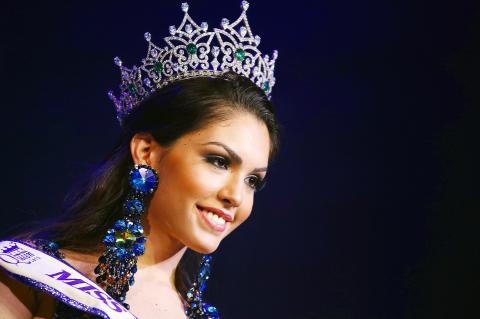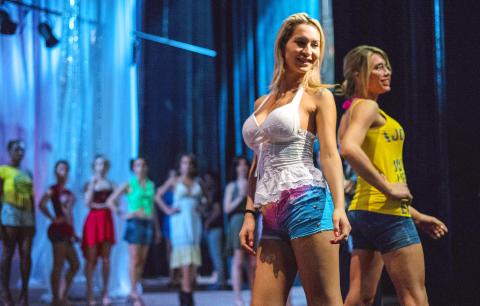As a young boy in Brazil’s heartland, Carol Marra watched her parents politely correct strangers who said what a pretty daughter they had. In her teenage years, she coveted the boyfriends of her female classmates and tried out androgynous outfits, dutifully changing back into a young man’s clothes in her car before returning home.
Now a favorite among Brazil’s growing class of transgender models, Marra, 26, has become a star. She filmed two mini-series for major Brazilian television channels, is starting a lingerie line and was the first transgender model to walk Fashion Rio — considered a top national runway event — and also the first to pose for Revista Trip, a Brazilian culture magazine that features female nudes.
Her popularity points to striking, if precarious, gains in Brazil’s popular culture for Marra and her small number of peers. In a country that publicly celebrates its mixed-race and multicultural heritage, Brazil’s cosmopolitan capitals like Sao Paulo and Rio de Janeiro have become places where crossing gender lines is increasingly accepted. Still, transgender models themselves say Brazil is also in many ways a deeply conservative country with strong religious forces that can create a hostile environment for its gay and transgender population.

Photo: Reuters
“They say Brazil is a liberal, progressive country, but it’s not really like that,” said Marra, as a stylist curled her long dyed-blond hair in the upscale Jardins neighborhood of Sao Paulo before a television shoot.
Marra herself has become a success story for a rising number of transgender models who, like her, migrated from more remote regions to Sao Paulo, considered the most important fashion hub of South America.
“When I arrived, I immediately felt the difference,” said Melissa Paixao, 22, who moved here at age 19.

Photo: AFP
She was born Robson Paixao in Belo Horizonte, a more traditional city in Brazil’s interior. As a teenager, she made extra cash posing as Marilyn Monroe and Audrey Hepburn in a store there and said she drew stares on the street, which she attributes less to prejudice than to being a 6-foot-tall woman.
Relative newcomers like Paixao, Camila Ribeiro and Felipa Tavares have gotten runway and catalog work in the national fashion market. Ribeiro walked in the Fashion Business show in Rio for Santa Ephigenia, a classy women’s wear brand. And Paixao will be in the coming catalog of Walerio Araujo, a Brazilian designer, who is known for flamboyant styles and has dressed Brazilian celebrities including singers like Preta Gil and Maria Rita.
The transgender models say that their experiences bear out the idea that progress in gaining social acceptance has been uneven despite the anything-goes image the nation projects. The country’s gay and transgender movements were stunted during the military dictatorship that steered the country from 1964 to 1985, years when similar movements were taking root in other countries, scholars of gay rights here say.

Photo: AFP
Gender-bending has a long history in Brazil; public cross-dressing peaks each year with the pre-Lenten Carnival celebrations. The participation of boisterous men in women’s clothing and crude makeup is as much a tradition as samba competitions.
Drag shows by transgender and gay performers became a fad in Rio nightclubs in the 1950s and 1960s, and in subsequent decades some transgender women began using hormonal treatments and silicone to feminize their bodies, according to James N. Green, a historian and the author of Beyond Carnival: Male Homosexuality in Twentieth-Century Brazil.
Brazil has also increasingly become supportive of gay rights. Sao Paulo hosts one of the world’s largest gay pride parade, and since 2010, the Brazilian judiciary has upheld gay couples’ rights to civil unions, adoption and marriage. But a proposal to distribute anti-discrimination kits in public schools was defeated by the government after evangelical members of Congress complained of its sexual content.
And violence and prejudice against the gay and transgender populations remain high. Grupo Gay da Bahia, a prominent gay rights group, reported 338 killings nationwide of gay, lesbian and transgender people in 2012. It is not possible to verify the motives for every crime, but many victims show marks of torture and multiple wounds, leading the group to believe such killings are often hate crimes, said Luiz Mott, the anthropologist and historian who founded the group.
Even as transgender models gain prominence, Green, the historian, argues that their success — while it is positive for those individuals — has little political value.
“I think it means that men who look like women, as long as they are submissive to men and focus on beauty and clothes, don’t threaten anything,” he said. “It fits into men’s fantasies.”
Some models see themselves as highly political while others say they are eager to be accepted as a woman like any other.
Roberta Close, who posed for Playboy in 1984, is considered Brazil’s first transgender model and cultivated a devoted male following with her girlish aesthetic. The actress Rogeria, born Astolfo Barroso Pinto, is a household name in Brazil after years of appearing on Globo TV.
Still, the proportion of transgender models is tiny considering the vast fashion industry here.
Brazil’s most internationally recognized transgender model — Lea T, born Leandro Cerezo and the son of a former soccer star, Toninho Cerezo — posed for a 2010 international Givenchy campaign. She also walked Sao Paulo Fashion Week with supermodels like Gisele Bundchen and Alessandra Ambrosio, who are known for their work for Victoria’s Secret.
Debora Souza, a modeling agent who represents Marra said, “A trans model is interesting because she can get two crowds: both the feminine crowd and the gay crowd, which is the main group of the fashion world.”
But once they venture beyond the confines of fashion, the models have enjoyed less success.
Ribeiro, 24, who comes from the Amazonian industrial city of Manaus, has posed for Candy, which calls itself the “first transversal style magazine.” But she said that despite being welcomed by fashion and artistic, experimental or avant-garde publications, transgender models had found it difficult to branch out into mainstream consumer magazines, catalogs, trade shows and ads for products with broad appeal.
Marra also said her own renown in the fashion world has not carried over to other realms. She said she has been inundated with vulgar messages from men on her Facebook page, often asking her how much she costs for a night.
“I never wanted to be an activist of the cause,” Marra said. “I thought I was a woman like any other.”
But she became more outspoken after receiving messages from transgender individuals in more remote corners of the country, like a prostitute in Manaus who saw her on TV and asked for guidance.
Marra also complained that she did not receive fair treatment in casting, saying that she was assigned only to roles of transgender women.
“The majority of actors are gay and they can play a heartthrob,” Marra told her director at her mini-series shoot. “Why can’t I play a maid, a secretary, a tree?”

May 26 to June 1 When the Qing Dynasty first took control over many parts of Taiwan in 1684, it roughly continued the Kingdom of Tungning’s administrative borders (see below), setting up one prefecture and three counties. The actual area of control covered today’s Chiayi, Tainan and Kaohsiung. The administrative center was in Taiwan Prefecture, in today’s Tainan. But as Han settlement expanded and due to rebellions and other international incidents, the administrative units became more complex. By the time Taiwan became a province of the Qing in 1887, there were three prefectures, eleven counties, three subprefectures and one directly-administered prefecture, with

It’s an enormous dome of colorful glass, something between the Sistine Chapel and a Marc Chagall fresco. And yet, it’s just a subway station. Formosa Boulevard is the heart of Kaohsiung’s mass transit system. In metro terms, it’s modest: the only transfer station in a network with just two lines. But it’s a landmark nonetheless: a civic space that serves as much more than a point of transit. On a hot Sunday, the corridors and vast halls are filled with a market selling everything from second-hand clothes to toys and house decorations. It’s just one of the many events the station hosts,

Among Thailand’s Chinese Nationalist Party (KMT) villages, a certain rivalry exists between Arunothai, the largest of these villages, and Mae Salong, which is currently the most prosperous. Historically, the rivalry stems from a split in KMT military factions in the early 1960s, which divided command and opium territories after Chiang Kai-shek (蔣介石) cut off open support in 1961 due to international pressure (see part two, “The KMT opium lords of the Golden Triangle,” on May 20). But today this rivalry manifests as a different kind of split, with Arunothai leading a pro-China faction and Mae Salong staunchly aligned to Taiwan.

Two moves show Taichung Mayor Lu Shiow-yen (盧秀燕) is gunning for Chinese Nationalist Party (KMT) party chair and the 2028 presidential election. Technically, these are not yet “officially” official, but by the rules of Taiwan politics, she is now on the dance floor. Earlier this month Lu confirmed in an interview in Japan’s Nikkei that she was considering running for KMT chair. This is not new news, but according to reports from her camp she previously was still considering the case for and against running. By choosing a respected, international news outlet, she declared it to the world. While the outside world